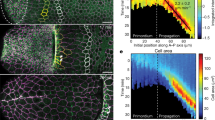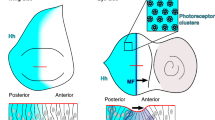Abstract
In Drosophila, each segmental primordium is subdivided into two cell populations, the anterior (A) and posterior (P) compartments by the selective activity of the transcription factor Engrailed (En) in P cells1,2,3,4. Under En control, P cells secrete, but cannot respond to, the signalling protein Hedgehog (Hh)5,6,7. In contrast, and by default, A cells are programmed to respond to Hh by expressing other signalling molecules, such as Decapentaplegic (Dpp) and Wingless (Wg), which organize growth and patterning in both compartments5,7,8,9. Cells of the A and P compartments do not intermix, apparently as a consequence of their having distinct cell affinities that cause them to maximize contact with cells of the same compartment, while minimizing contact with cells from the other compartment10. This failure to mix has previously been ascribed to an autonomous and direct role for En in specifying a P, as opposed to an A, cell affinity3,11,12,13. However, an alternative hypothesis is that Hh secreted by P cells induces A cells to acquire a distinct cell affinity, ensuring that a stable ‘affinity boundary’ forms wherever P and A cells meet. Here we show that the affinity boundary that segregates A and P cells into adjacent but immiscible cell populations is to a large extent a consequence of local Hh signalling, rather than a reflection of an intrinsic affinity difference between A and P cells.
This is a preview of subscription content, access via your institution
Access options
Subscribe to this journal
Receive 51 print issues and online access
$199.00 per year
only $3.90 per issue
Buy this article
- Purchase on Springer Link
- Instant access to full article PDF
Prices may be subject to local taxes which are calculated during checkout



Similar content being viewed by others
References
Garcia-Bellido, A., Ripoll, P. & Morata, G. Developmental compartmentalization of the wing disk of Drosophila. Nature 246, 251–253 (1973).
Garcia-Bellido, A., Ripoll, P. & Morata, G. Developmental compartmentalization in the dorsal mesothoracic disc of Drosophila. Dev. Biol. 48, 132–147 (1976).
Morata, G. & Lawrence, P. A. Control of compartment development by the engrailed gene in Drosophila. Nature 255, 614–617 (1975).
Kornberg, T., Siden, I., O'Farrell, P. & Simon, M. The engrailed locus of Drosophila: in situ localization of transcripts reveals compartment-specific expression. Cell 40, 45–53 (1985).
Basler, K. & Struhl, G. Compartment boundaries and the control of Drosophila limb pattern by Hedgehog protein. Nature 368, 208–214 (1994).
Tabata, T. & Kornberg, T. B. Hedgehog is a signaling protein with a key role in patterning Drosophila imaginal discs. Cell 76, 89–102 (1994).
Zecca, M., Basler, K. & Struhl, G. Sequential organizing activities of engrailed, hedgehog and decapentaplegic in the Drosophila wing. Deveopment 121, 2265–2278 (1995).
Tabata, T., Schwartz, C., Gustavson, E., Ali, Z. & Kornberg, T. B. Creating a Drosophila wing de novo, the role of engrailed, and the compartment border hypothesis. Development 121, 3359–3369 (1995).
Capdevila, J. & Guerrero, I. Targeted expression of the signaling molecule decapentaplegic induces pattern duplications and growth alterations in Drosophila wings. EMBO J. 13, 4459–4468 (1994).
Garcia-Bellido, A. Genetic control of wing disc development in Drosophila. Ciba Found. Symp. 161–182 (1975).
Lawrence, P. A. & Struhl, G. Further studies of the engrailed phenotype in Drosophila. EMBO J. 1, 827–833 (1982).
Blair, S. S. Compartments and appendage development in Drosophila. Bioessays 17, 299–309 (1995).
Lawrence, P. A. & Struhl, G. Morphogens, compartments, and pattern: lessons from Drosophila ? Cell 85, 951–961 (1996).
Nüsslein-Volhard, C., Wieschaus, E. & Kluding, H. Mutations affecting the pattern of the larval cuticle in Drosophila melanogaster: I. Zygotic loci on the second chromosome. Wilhelm Roux Arch. Dev. Biol. 193, 267–282 (1984).
Alcedo, J., Ayzenzon, M., Von Ohlen, T., Noll, M. & Hooper, J. E. The Drosophila smoothened gene encodes a seven-pass membrane protein, a putative receptor for the hedgehog signal. Cell 86, 221–232 (1996).
van den Heuvel, M. & Ingham, P. W. smoothened encodes a receptor-like serpentine protein required for hedgehog signalling. Nature 382, 547–551 (1996).
Chen, Y. & Struhl, G. Dual roles for Patched in sequestering and transducing Hedgehog. Cell 87, 553–563 (1996).
Xu, T. & Rubin, G. M. Analysis of genetic mosaics in developing and adult Drosophila tissues. Development 117, 1223–1237 (1993).
Dunin, B. O. & Brown, N. H. Mammalian CD2 is an effective heterologous marker of the cell surface in Drosophila. Dev. Biol. 168, 689–693 (1995).
Jiang, J. & Struhl, G. Protein kinase A and Hedgehog signaling in Drosophila limb development. Cell 80, 563–572 (1995).
Hama, C., Ali, Z. & Kornberg, T. B. Region-specific recombination and expression are directed by portions of the Drosophila engrailed promoter. Genes Dev. 4, 1079–1093 (1990).
Lawrence, P. A. in Drosophila: a Practical Approach (eds Roberts, D. B.) 229–242 (IRL, Oxford, (1986)).
Burke, R. & Basler, K. Dpp receptors are autonomously required for cell proliferation in the entire developing Drosophila wing. Development 122, 2261–2269 (1996).
Lawrence, P. A. & Morata, G. Compartments in the wing of Drosophila: a study of the engrailed gene. Dev. Biol. 50, 321–337 (1976).
Li, W., Ohlmeyer, J. T., Lane, M. E. & Kalderon, D. Function of protein kinase A in hedgehog signal transduction and Drosophila imaginal disc development. Cell 80, 553–562 (1995).
Pan, D. & Rubin, G. M. cAMP-dependent protein kinase and hedgehog act antagonistically in regulating decapentaplegic transcription in Drosophila imaginal discs. Cell 80, 543–552 (1995).
Ingham, P. W., Taylor, A. M. & Nakano, Y. Role of the Drosophila patched gene in positional signalling. Nature 353, 184–187 (1991).
Phillips, R. G., Roberts, I. J., Ingham, P. W. & Whittle, J. R. The Drosophila segment polarity gene patched is involved in a position-signalling mechanism in imaginal discs. Development 110, 105–114 (1990).
Johnson, R. L., Grenier, J. K. & Scott, M. P. Patched overexpression alters wing disc size and pattern: transcriptional and post-transcriptional effects on hedgehog targets. Development 121, 4161–4170 (1995).
Lindsley, D. L. & Zimm, G. G. The Genome of Drosophila melanogaster (Academic, San Diego, (1992)).
Motzny, C. K. & Holmgren, R. The Drosophila cubitus interruptus protein and its role in the wingless and hedgehog signal transduction pathways. Mech. Dev. 52, 137–150 (1995).
Acknowledgements
We thank J. Nüsslein-Volhard, Y. Chen and G. Struhl for fly stocks; R. Burke, C.Dahmann, N. Méthot and particularly G. Struhl for comments on the manuscript; F. Cifuentes, D.Nellen and M. Zecca for help with the clonal analysis; and J. Modolell for support. I.R. was the recipient of an EMBO fellowship. This work was supported by the Swiss National Science Foundation, the Direccion general de Investigacion Cientifica y Tecnica, and the Fundacion Ramon Areces.
Author information
Authors and Affiliations
Corresponding author
Rights and permissions
About this article
Cite this article
Rodriguez, I., Basler, K. Control of compartmental affinity boundaries by Hedgehog. Nature 389, 614–618 (1997). https://doi.org/10.1038/39343
Received:
Accepted:
Issue Date:
DOI: https://doi.org/10.1038/39343
This article is cited by
-
Differential cell adhesion implemented by Drosophila Toll corrects local distortions of the anterior-posterior compartment boundary
Nature Communications (2020)
-
Hedgehog mediated degradation of Ihog adhesion proteins modulates cell segregation in Drosophila wing imaginal discs
Nature Communications (2017)
-
Boundary formation and maintenance in tissue development
Nature Reviews Genetics (2011)
-
Establishment and maintenance of compartmental boundaries: role of contractile actomyosin barriers
Cellular and Molecular Life Sciences (2011)
-
Ihog and Boi are essential for Hedgehog signaling in Drosophila
Neural Development (2010)
Comments
By submitting a comment you agree to abide by our Terms and Community Guidelines. If you find something abusive or that does not comply with our terms or guidelines please flag it as inappropriate.



